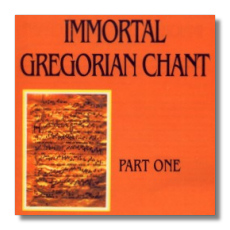
The Internet's Premier Classical Music Source
Related Links
- Latest Reviews
- More Reviews
-
By Composer
-
Collections
DVD & Blu-ray
Books
Concert Reviews
Articles/Interviews
Software
Audio
Search Amazon
Recommended Links
Site News
 CD Review
CD Review
Immortal Gregorian

A Journey Through the Gregorian Year
Part One - Advent, Palm Sunday, Christmas, Holy Thursday, Epiphany & Good Friday
Monks of the Abbeys of Orval, Liguge, Citeaux, Becitellouin, En Calcat, St. Wandrille
Choirs of the Institut St. Gregoire at Lyons, of the Basilica of Beaune, and of the University of Strasbourg
Studio SM 12201 AAD 1991 55:25


Part Two - Lent, All Saints, Pentecost, All Souls & Corpus Christi
Monks of the Abbeys of Kergonan, St. Wandrille, En Calcat, and Bricquebec
Choirs of the Institut St. Gregoire at Lyons and of l'Arche
Choirs of the Cathedrals of Dijon, Rennes, and of Anger
Choirs of the Basilicas of Beaune and Monserrat; the Holy Spirit Fathers at Chevilly; and Magdalith and Dom de Malherbe
Studio SM 12202 AAD 1991 61:13
Gregorian is a deceptively simple term. To those not acquainted with the chant itself, it suggests a large homogeneous body of music performed with ritual, even quasi-military, precision in conjunction with Roman Catholic ceremonial. To those who grew up in the pre-Vatican II Church (which went out with a whimper about 1963), the chant was a part of daily life: in the morning, afternoon, and evening – even through the night – monastic choirs lifted their voices unceasingly in plainsong, and the rest of the church followed as closely as the rhythms of lay life would allow. In the United States, unlike in Europe, it is no longer a living tradition. Yet not so many years ago, even here, so far removed geographically and culturally from European fatherlands, thousands of children began their school days to the glow of candles, the colors of the liturgical seasons, and, of course, the chant. Sister pointed out that the school was under the same roof as the church, that the day was therefore spent in the intimate presence of the Blessed Sacrament, and that the day's every thought, word, act and emotion, playing, learning, eating, laughing, and crying, should therefore rise to the throne of God as naturally as so many wisps of incense before the tabernacle.
Chant was the music of such a day, celebrating, mourning, praising, waiting. It set apart time spent with the eternal God from time spent in pursuit of earthly pleasure. The title "Immortal Gregorian" would not have seemed out of place in those days. But the chant was never monolithic. Despite the precepts of Vatican liturgists, it was performed throughout the world unharmonized, harmonized with tonal or modal or Debussy-like accompaniments, in various rhythms, in no rhythms at all, by men, by women, by boys, by girls, and by everybody all together. While the version based on the scholarship of the Solesmes monks enjoyed ecclesiastical approbation, its high and somewhat impersonal standards were seldom realized. Something so integrally interwoven into the fabric of life is bound to be personalized, despite the efforts of scholars to maintain historical purity and aesthetic objectivity.
Gregorian chant has recently become a commercial success, and record companies are releasing or re-releasing their archival material to ride the crest of the wave. Some of these recordings were already in preparation and are simply being issued at the most favorable time, some are more opportunistic. Some are excellent, some are not. Some are academically enlightened, some are not. But no others have the impact of this set. Its concept is so beautifully realized that it transcends the boundaries of simple musical experience. SM has been collecting performances of chant in French and Belgian monasteries since the early years of recording and established a partnership based on trust and mutual respect with these great houses of prayer at a time when chant was too pervasive to be popular or exploitable. The performances in this traversal of the ecclesiastical year were in fact collected through the years and finally reissued in this set in 1991, well before the current rage began. Everything is here – every style and crack-brained attempt to personalize the chant. The range is simply incredible. Two sumptuous booklets tell the whole story, explaining the provenance of each style and medium and the significance of each example in the great cycle of the ecclesiastical year. The only thing lacking is the date of most of the individual recordings.
The recent success of Anonymous 4's discs of medieval polyphony was the first indication that a hunger was waiting to be satisfied. The current Gregorian furor is therefore not so surprising – nor is it surprising that it was initiated by a disc distinguished for neither scholarship nor performance. But if a real hunger and a real thirst are being satisfied, then this offering by SM should rise immediately to the top. From the first pealing of the bells of the Cistercian Abbey of Orval to the realization that my wife was crying in the next room as she listened, it was clear that this is the real thing, the chant as actually sung and experienced by generations of the devout. Here is an exploration of an important body of music as it was actually performed, but more importantly, too, a descent into the depths of religious consciousness. The experience transcends the doctrines of Roman Catholicism, although it is an epitome of that religious ethos. In view of the project's scope, the poor quality of some of the recordings seems trivial and irrelevant.
To those who listen to chant as an academic exercise, other discs may afford a drink at a purer stream. But generations from now, this set will still live. It is a vital document as immortal as the Gregorian it surveys and immediately recognizable as a part of our collective psyche. Required listening.
Copyright © 1996, Robert Maxham


















